Analysis of Chip Morphology in Heavy Milling of 508III Steel Considering Different Tool Wear Conditions
Abstract
:1. Introduction
- (1)
- Investigating the macroscopic and microscopic changes in chip morphology under different tool wear conditions lays a theoretical foundation for identifying tool wear and breakage states based on chip morphology.
- (2)
- The scratching and plowing phenomena observed on the chip’s bottom surface reflect the severity of tool–chip friction, which to some extent characterizes the tool wear state.
- (3)
- Comparing heavy milling conditions with conventional cutting conditions allows us to explore the significant differences in the chip edge generated at the non-free and free ends of chips.
- (4)
- The study reveals the reasons for the differences in the microscopic morphology of the chip’s free surface under different tool wear conditions.
2. Heavy Milling 508III Steel Experiments
2.1. Workpiece Material Characteristics
2.2. Experimental Program
2.3. Chip Data Collection
3. Chip Morphology Analysis
3.1. Chip Free Surface Morphology Analysis
3.2. Chip Bottom Surface Morphology Analysis
4. Analysis of Chip Edges Morphology
5. Analysis of Chip Curl Pattern in Heavy Milling 508III Steel
6. Conclusions
- (1)
- The chips produced during heavy milling of 508III steel differ significantly from ordinary chips, and there are notable differences in the macro-morphologies and micro-morphologies of the chip’s free surface at different stages of tool wear. Macroscopically, the size of the chips is large and the color of their free surfaces varies significantly; the color of the chip varies along the chip width direction. When the tool wear reaches the stage of severe wear, there is a clear strip of color band on the free surface of the chip. Microscopically, there are a lot of folds on the free surface of the chip with shear slip, and the free surface of the chip is characterized by a “pomelo meat” shape in the initial and steady wear stages of the tool. During the severe wear stage, the “pomelo meat-shaped” folds become relatively suppressed, and microcracks start to appear between the fold units. Additionally, the free surface of the chip tends to be close to the “layered-rock shape”.
- (2)
- Due to the action with the front insert surface, a more obvious scratch is formed on the bottom surface of the chip. As the tool wear increases, the scratching and plowing phenomenon is more significant. The initial wear and steady wear stage of the chip edge size is small. Severe wear on the chip edge produces deeper cracks and a larger chip edge size. Furthermore, all the cracks and scratches are on the chip edge. The bottom surface of the chip under the severe wear stage has more obvious adiabatic shear band marks than the initial wear and steady-wear stages. The severe wear stage has more serious chip bonding phenomena and parallel scratches, and when the tool is about to reach the dull standard, the roughness of the chip bottom surface reaches 7.76 μm.
- (3)
- The non-free and free ends of chips show different patterns at different wear stages. In the initial stage of tool wear, the non-free end of milling 508III steel chips shows different degrees of chip edge morphology, while the free end is relatively smooth. The chip edge on the free end of the chips formed gradually during the 11th pass in heavy milling of 508III steel; both the non-free end and free end of the chip show chip edge morphology, and there are more obvious changes. During the examination of chip morphology at various stages of tool wear, it was noted that the chips not only exhibit lateral plastic flow phenomena but also manifest noticeable cracks.
- (4)
- Different chip patterns at different wear stages. During the initial phase of tool wear, the chip exhibits varying degrees of C-type curling. As the tool progresses to the steady-wear stage, the morphology of the chip transforms into a strip configuration characterized by elongation and a greater radius of curvature. The expansion of the chip initiates with lateral curling, eventually evolving into an upward curling pattern that is typically seen in strip chips. During the severe wear stage of the tool, there is an increase in the degree of upward curling of the chip, leading to a gradual reduction in the radius of curvature at the end of the chip.
Author Contributions
Funding
Institutional Review Board Statement
Informed Consent Statement
Data Availability Statement
Conflicts of Interest
References
- Liu, X.; Li, X.; Ding, M.; Yue, C.; Wang, L.; Liang, Y.; Zhang, B. Intelligent Management and Control Technology of Cutting Tool Life-cycle for Intelligent Manufacturing. J. Mech. Eng. 2021, 57, 196–219. [Google Scholar]
- Rai, R.; Tiwari, M.; Ivanov, D.; Dolgui, A. Machine learning in manufacturing and industry 4.0 applications. Int. J. Prod. Res. 2021, 59, 4773–4778. [Google Scholar] [CrossRef]
- Mikhailov, V.; Kovelenov, Y.; Bolotskikh, V. Simulation of Chip Formation and Fracture in the Design of Complex Turning Inserts. Russ. Eng. Res. 2018, 38, 566–572. [Google Scholar] [CrossRef]
- Khashaba, U. Analysis of surface roughness, temperature, short aging, and residual notched and bearing strengths in supported drilling of thin GFRP composites. Alex. Eng. J. 2024, 86, 157–173. [Google Scholar] [CrossRef]
- Rabinarayan, B.; Amlana, P.; Kumar, A. Machinability characteristics analysis of hard turning operation on AISI 4340 steel using physical vapor deposition multilayer coated carbide cutting tool in the dry environment. Proc. Inst. Mech. Eng. Part E J. Process Mech. Eng. 2023, 237, 2222–2233. [Google Scholar]
- Cheng, Y.; Gai, X.; Guan, R. Temperature Experiment and Parameter Optimization of Cemented Carbide Tool in Milling 508III Steel. Materials 2023, 16, 2833. [Google Scholar] [CrossRef] [PubMed]
- Cheng, Y.; Li, C.; Yuan, Q.; Lv, Q.; Liu, L. Experiment and model of cutting force of heavy-duty milling water chamber head material. SN Appl. Sci. 2019, 1, 1571. [Google Scholar] [CrossRef]
- Wu, M.; Zhao, X.; Chen, Y.; Xu, M.; Cheng, Y.; Li, L. Reaserch on Mechanism and Experimental of Chip Breaking during High Pressure Cooling Turning of Superalloys with PCBN Tool. J. Mech. Eng. 2017, 53, 187–192. [Google Scholar] [CrossRef]
- Devotta, A.; Beno, T.; Löf, R. Finite element modelling and characterisation of chip curl in nose turning process. Int. J. Mach. Mach. Mater. 2017, 19, 277–295. [Google Scholar] [CrossRef]
- Gaurav, S. Experimental investigation of micro-pillar textured WC inserts during turning of Ti6Al4V under various cutting ffuid strategies. J. Manuf. Process. 2024, 113, 61–75. [Google Scholar]
- Sun, S.; Brandt, M.; Dargusch, M. Effect of tool wear on chip formation during dry machining of Ti-6Al-4V alloy, part 1: Effect of gradual tool wear evolution. Proc. Inst. Mech. Eng. Part B J. Eng. Manuf. 2017, 231, 1559–1574. [Google Scholar] [CrossRef]
- Vincent, W.; Maher, B.; Gilles, D. The relationship between the cutting speed, tool wear, and chip formation during Ti-5553 dry cutting. Int. J. Adv. Manuf. Tech. 2015, 76, 893–912. [Google Scholar]
- Cui, X.; Zhao, B.; Jiao, F.; Zheng, J. Chip formation and its effects on cutting force, tool temperature, tool stress, and cutting edge wear in high- and ultra-high-speed milling. Int. J. Adv. Manuf. Tech. 2015, 76, 893–912. [Google Scholar] [CrossRef]
- Demirpolat, H.; Binali, R.; Patange, A. Comparison of Tool Wear, Surface Roughness, Cutting Forces, Tool Tip Temperature, and Chip Shape during Sustainable Turning of Bearing Steel. Materials 2023, 16, 4408. [Google Scholar] [CrossRef] [PubMed]
- Gdula, M.; Mrowka-Nowotnik, G. Analysis of tool wear, chip and machined surface morphology in multi-axis milling process of Ni-based superalloy using the torus milling cutter. Wear 2023, 520–521, 204652. [Google Scholar] [CrossRef]
- Das, A.; Bajpai, V. Machinability analysis of lead free brass in high speed micro turning using minimum quantity lubrication. Cirp. J. Manuf. Sci. Tec. 2023, 41, 180–195. [Google Scholar] [CrossRef]
- Che, J.; Zhang, Y.; Wang, H.; Chen, J.; Du, M. An experimental and numerical study on the wear mechanism of cutters on workover bits under thermo-mechanical coupling. Geoenergy Sci. Eng. 2023, 224, 211628. [Google Scholar] [CrossRef]
- Guan, R.; Cheng, Y.; Zhou, S.; Gai, X.; Lu, M.; Xue, J. Research on tool wear classification of milling 508III steel based on chip spectrum feature. Int. J. Adv. Manuf. Tech. 2024, 133, 1531–1547. [Google Scholar] [CrossRef]
- Cheng, Y.; Lu, M.; Gai, X.; Guan, R.; Zhou, S.; Xue, J. Research on Multi-Signal Milling Tool Wear Prediction Method Based on GAF-ResNext. Robot CIM-Int. Manuf. 2024, 85, 102634. [Google Scholar] [CrossRef]
- Wang, R.; Wang, X.; Pei, Y. The effects of cryogenic cooling on tool wear and chip morphology in turning of tantalum-tungsten alloys Ta-2.5W. J. Manuf. Process. 2023, 86, 152–162. [Google Scholar] [CrossRef]
- Anirban, M.; Ho, Y.; Yang, G. Sinuous flow and folding in metals: Implications for delamination wear and surface phenomena in sliding and cutting. Wear. 2017, 376, 1534–1541. [Google Scholar]
- Udupa, A.; Sugihara, T.; Mann, J. Glues make gummy metals easy to cut. J. Manuf. Sci. Eng. 2019, 141, 5. [Google Scholar] [CrossRef]
- Cui, F.; Xie, Y.; Dong, X.; Hou, L. Simulation analysis of metal flow in high-speed cold roll-beating. Appl. Mech. Mater. 2014, 33, 467–471. [Google Scholar] [CrossRef]
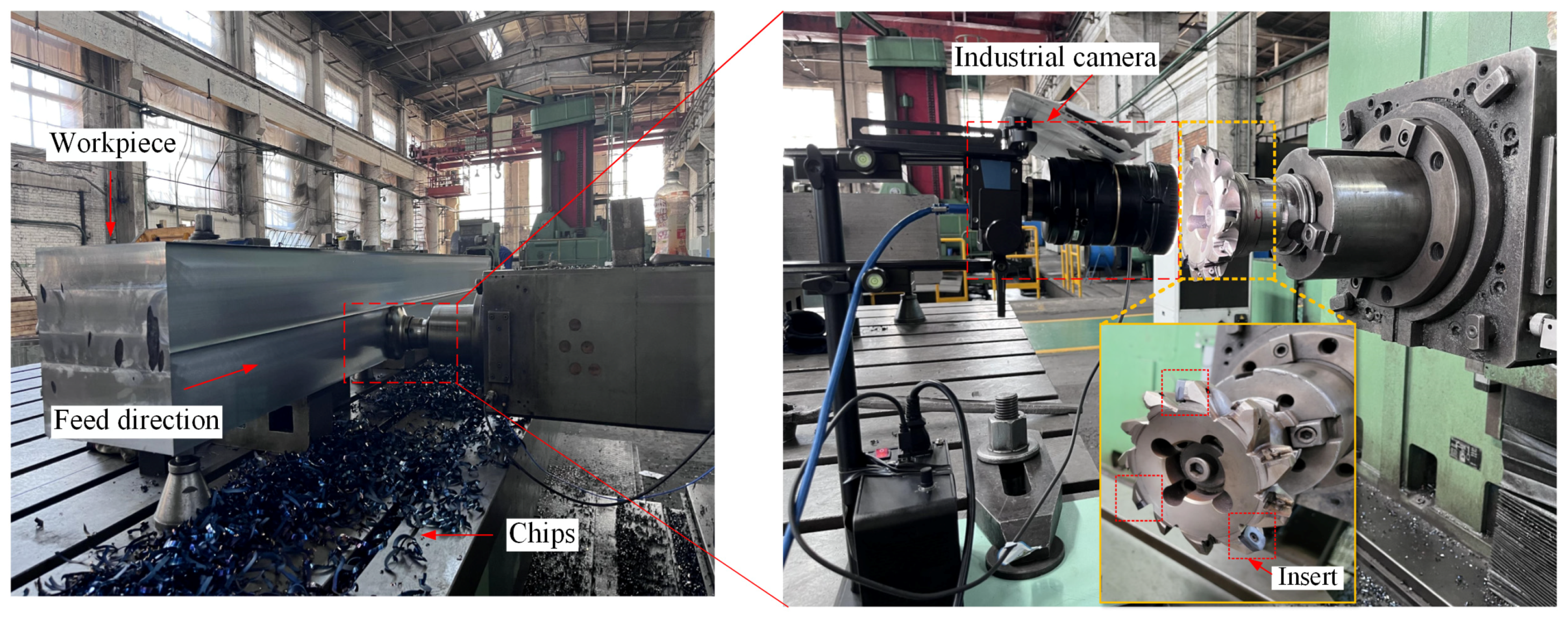

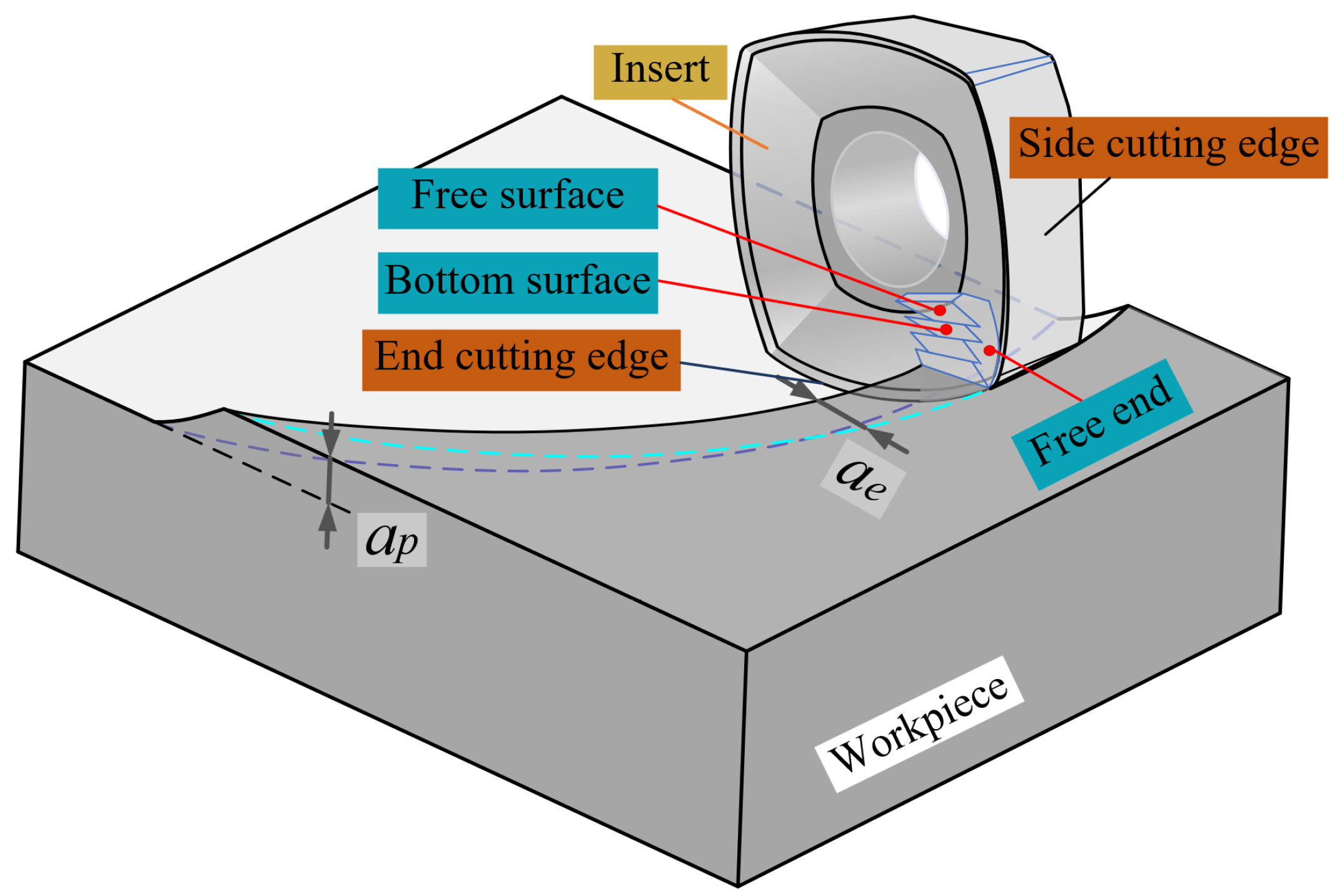

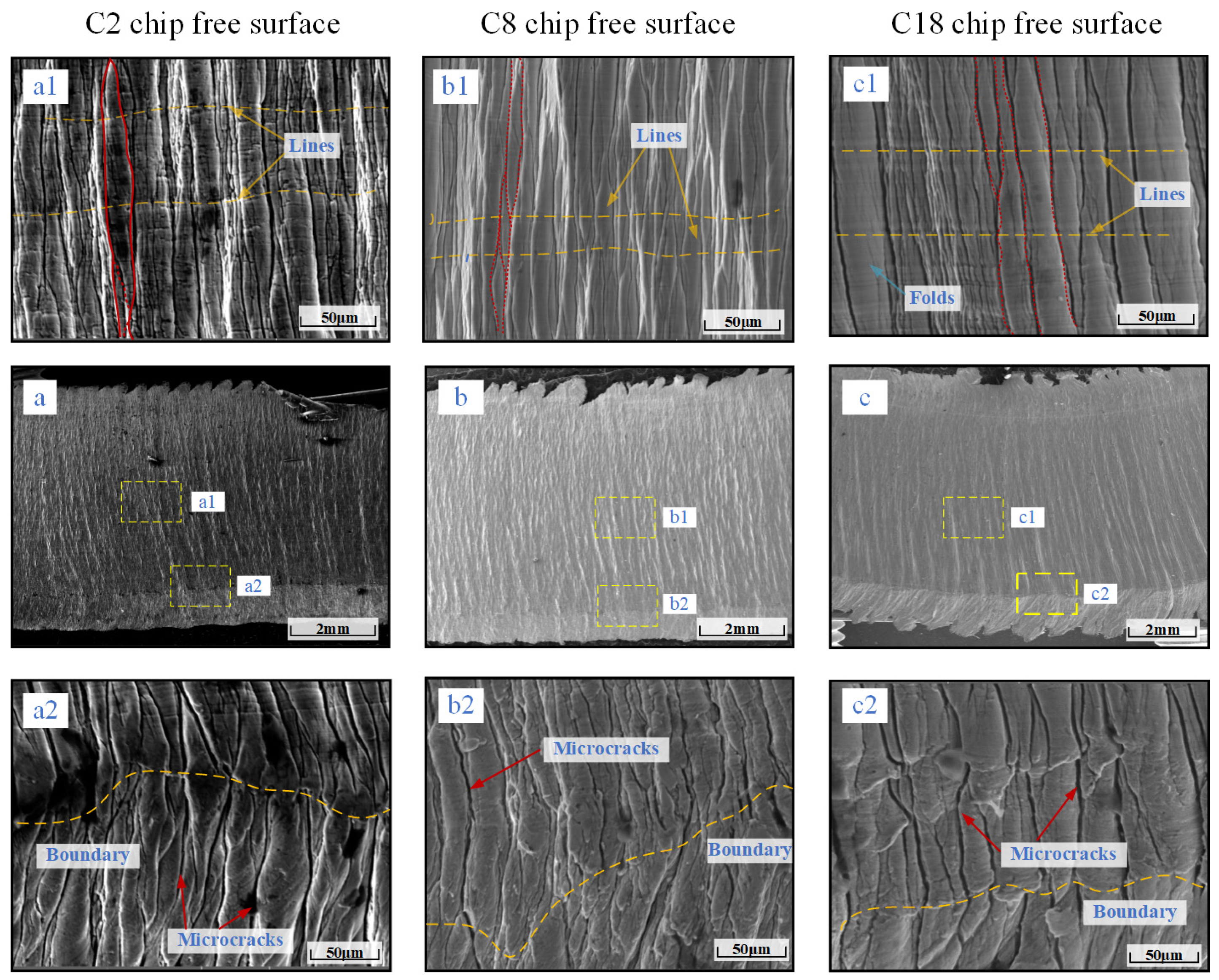
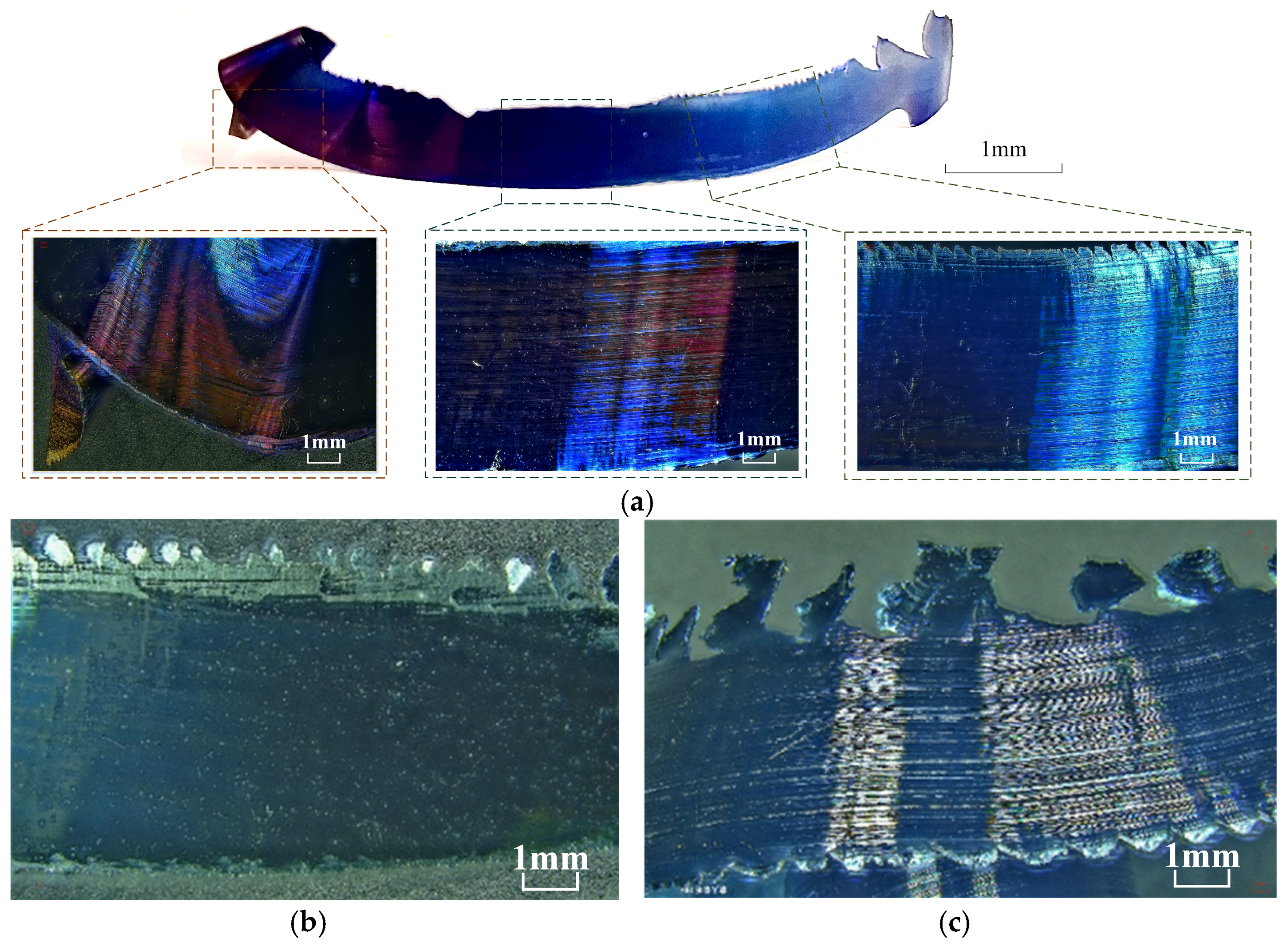
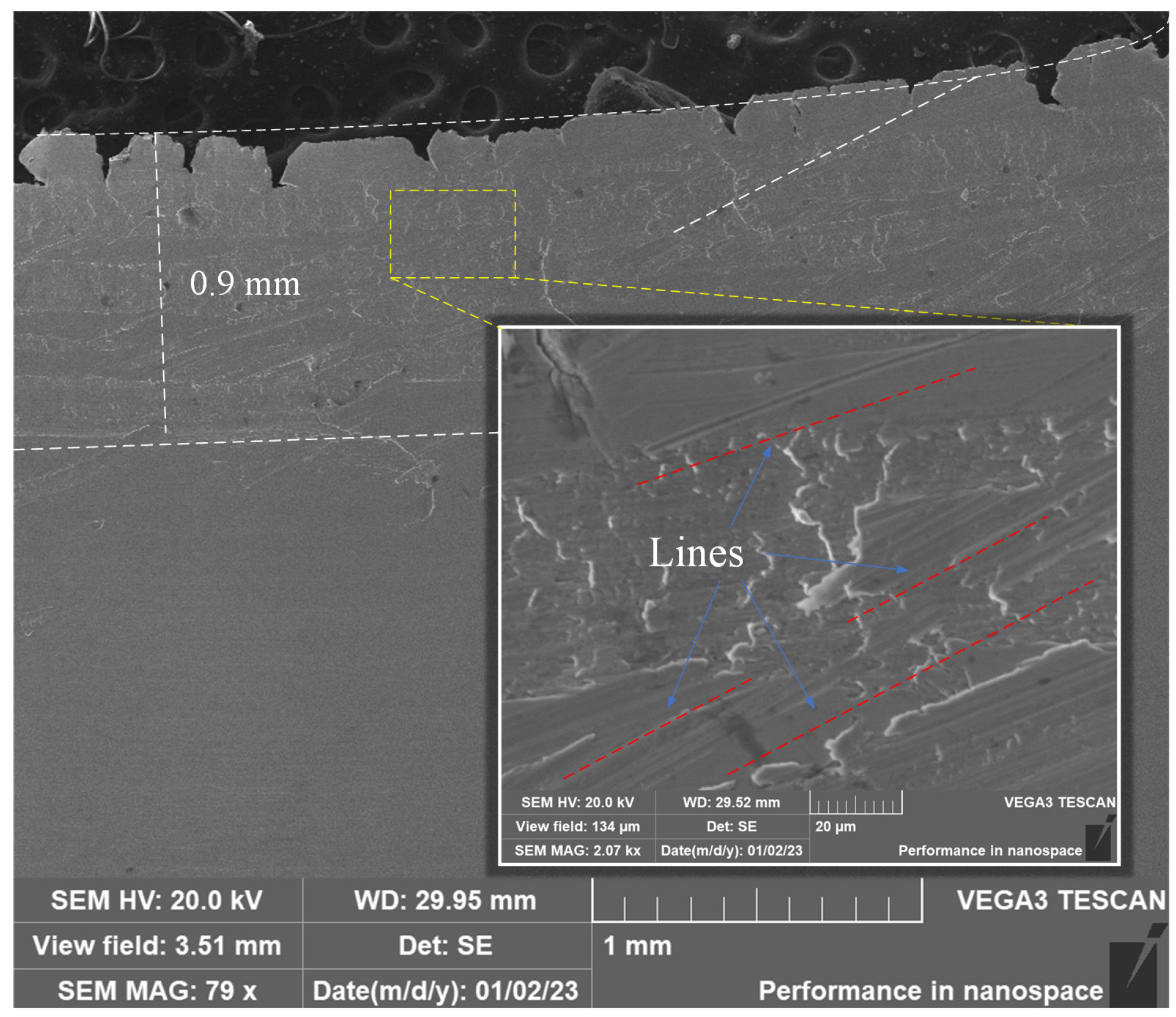



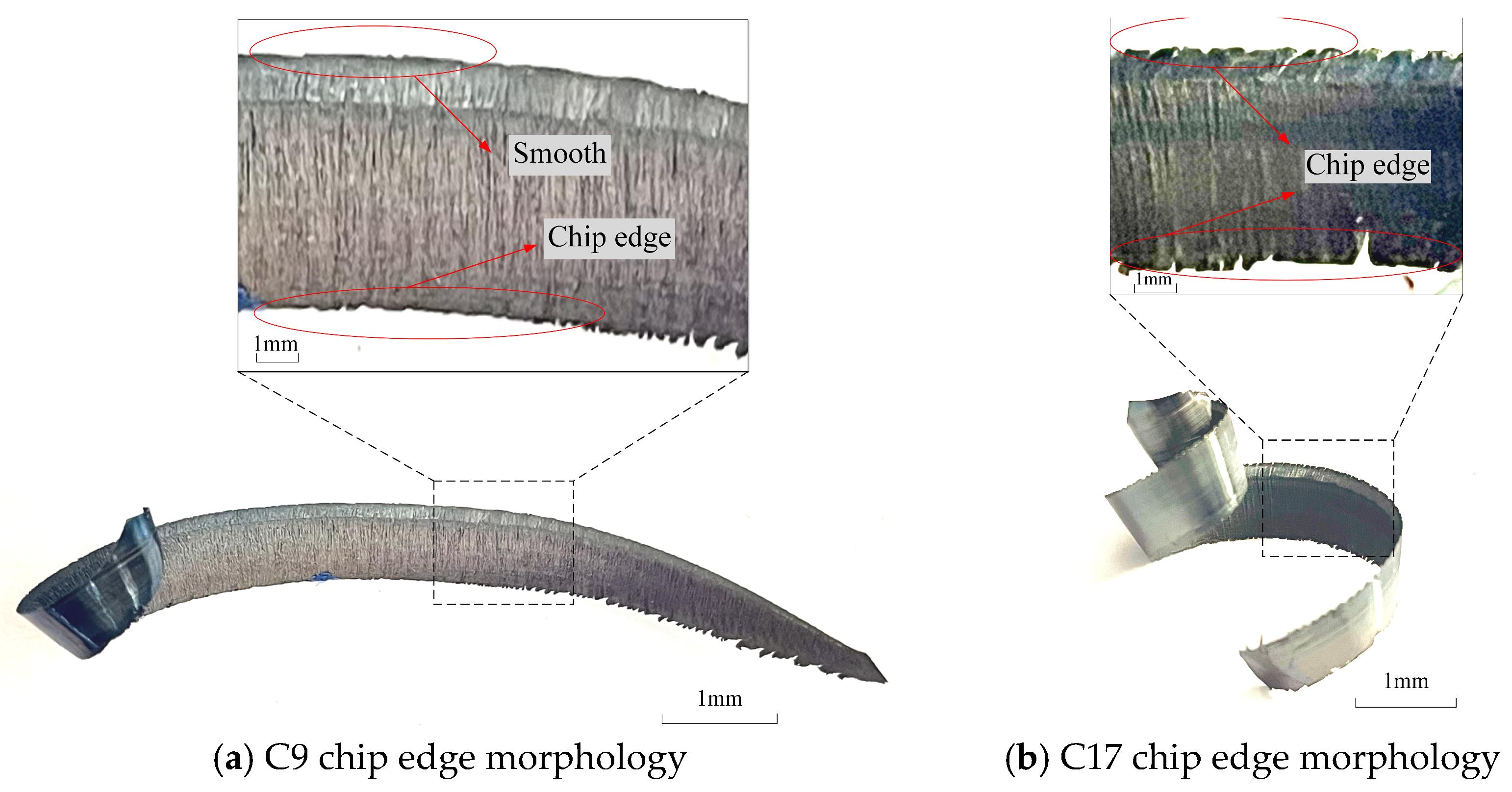


| Ingredient | w (C) | w (Si) | w (Mn) | w (P) | w (S) | w (Cr) | w (Ni) | w (Mo) | w (V) |
|---|---|---|---|---|---|---|---|---|---|
| Norm | 0.17~0.23 | 0.15~0.30 | 1.12~1.50 | ≤0.012 | ≤0.015 | ≤0.25 | 0.57~0.93 | 0.40~0.60 | ≤0.01 |
| Real measurement | 0.18 | 0.17 | 1.4 | 0.005 | 0.003 | 0.14 | 0.79 | 0.51 | 0.005 |
| Temperature | Mpa | Mpa | % | % |
|---|---|---|---|---|
| Longitudinal room temperature | 530 | 632 | 27.5 | 75 |
| Longitudinal 350 °C | 415 | 563 | 19.5 | 75 |
| Lateral room temperature | 481 | 614 | 29 | 75 |
| Lateral 350 °C | 481.5 | 555.5 | 19.5 | 75 |
| Relevant Parameters | Corner Radius | Cutting Edge Length | Insert Thickness | Coating Name | Coating Thickness |
|---|---|---|---|---|---|
| Values | 1.5 mm | 19 mm | 6.35 mm | CTPP235 | 4 μm |
| Points | O | Al | Ti | Cr | Fe | Ni | Nb | W |
|---|---|---|---|---|---|---|---|---|
| Point 1 | 42.89 | 0.06 | 0.00 | 0.20 | 56.64 | 0.07 | 0.12 | 0.02 |
| Point 2 | 39.22 | 0.00 | 0.15 | 0.02 | 60.51 | 0.10 | 0.00 | 0.00 |
| Point 3 | 38.35 | 0.45 | 0.14 | 0.06 | 60.47 | 0.52 | 0.02 | 0.00 |
Disclaimer/Publisher’s Note: The statements, opinions and data contained in all publications are solely those of the individual author(s) and contributor(s) and not of MDPI and/or the editor(s). MDPI and/or the editor(s) disclaim responsibility for any injury to people or property resulting from any ideas, methods, instructions or products referred to in the content. |
© 2024 by the authors. Licensee MDPI, Basel, Switzerland. This article is an open access article distributed under the terms and conditions of the Creative Commons Attribution (CC BY) license (https://creativecommons.org/licenses/by/4.0/).
Share and Cite
Guan, R.; Cheng, Y.; Xue, J.; Zhou, S.; Zhou, X.; Zhai, W. Analysis of Chip Morphology in Heavy Milling of 508III Steel Considering Different Tool Wear Conditions. Materials 2024, 17, 3948. https://doi.org/10.3390/ma17163948
Guan R, Cheng Y, Xue J, Zhou S, Zhou X, Zhai W. Analysis of Chip Morphology in Heavy Milling of 508III Steel Considering Different Tool Wear Conditions. Materials. 2024; 17(16):3948. https://doi.org/10.3390/ma17163948
Chicago/Turabian StyleGuan, Rui, Yaonan Cheng, Jing Xue, Shilong Zhou, Xingwei Zhou, and Wenjie Zhai. 2024. "Analysis of Chip Morphology in Heavy Milling of 508III Steel Considering Different Tool Wear Conditions" Materials 17, no. 16: 3948. https://doi.org/10.3390/ma17163948






